|
|
1
8
7
4
|
|
The
Grande Jatte
|
1
8
8
6
|
 |
 |
|
DEBUSSY-Reflections
in the Water (1904)
|
|
Biographies (click  painter's name) painter's name)
|
 Georges SEURAT (1859-1891), founder of
Divisionism
Georges SEURAT (1859-1891), founder of
Divisionism
| |
The term Neo-Impressionism refers to a
pictorial technique where color pigments are
no longer mixed either on the palette or directly on canvas, but
instead placed as small dots side by side. Mixing of colors takes place
from a suitable distance, in the observor's eye, as an "optical
mixture".
In the early 1880s, French painter Georges Seurat
studied
writings on color theory by French chemists Eugène Chevreul (1786-1889),
Charles Henry, and American physicist Ogden Rood, and
invented
a new painting technique that he named "separation of color"
or "Divisionism", the main advantage of which is to
give a greater vibrancy of color.
Seurat's first large painting (206x305cm) "A
Sunday Afternoon on the Island of La Grande Jatte" - 1884-1886
may be considered as the founding masterpiece of Divisionism.
|
|
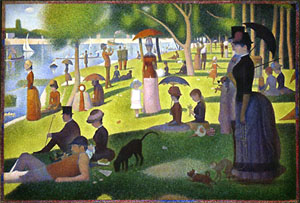 A Sunday Afternoon
A Sunday Afternoon
on the Island of La Grande Jatte
Georges SEURAT, 1884-86
The Art Institute of Chicago
|
 1886, the beginnings of
post-Impressionism : Symbolism and Neo-impressionism currents
1886, the beginnings of
post-Impressionism : Symbolism and Neo-impressionism currents
"A Sunday Afternoon on the Island of La Grande
Jatte " was first exhibited at the last Impressionist
Group Exhibition of 1886 where Pissarro
forced the presence of Seurat and
Paul Signac - who will later become the
main propagandist of Divisionism - on Monet, Renoir, Sisley and
Caillebotte who would retire from the exhibition.
1886 may be seen as a turning point in
French painting :
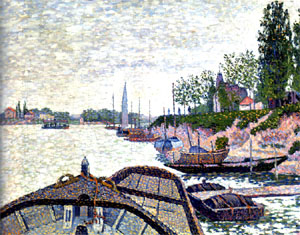 Front of Tub
Front of Tub
Paul Signac, 1888
Private collection |
|
|
Looking at Seurat's Divisionism in this context,
it appears at its beginnings to be only a pictorial variation of
Impressionism, which Pissarro will call "a scientific
Impressionism". Technics changes, but subjects and
realism remain impressionist.
Seurat died at the age of only
32, leaving a major individual work.
Signac later renamed
Divisionism as "Pointillism", but as soon as 1886,
writer and art critics Félix Fénéon, who will become
Divisionism greatest defender, call it "Neo-Impressionism".
|
 Neo-impressionism spreads
from France to Europe
Neo-impressionism spreads
from France to Europe
Neo-impressionist painters will regularly exhibit their
paintings at the Salon des Indépendants. This new
Exhibition fair was created in 1884 on the initiative
of some 400 artists disappointed with the Official "Salon de Paris",
and will be opened to all artists without any jury.
| |
At the first Salon des Independants of 1884, Seurat met Signac
(1863-1935) and a few other painters who will soon form the first
Neo-Impressionist circle : Albert Dubois-Pillet (1846-1890),
Charles Angrand (1856-1926) et Henri-Edmond Cross
(1856-1910).
With his painting "A Sunday
Afternoon
on the Island of La Grande Jatte " exhibited twice at the
Impressionist
Show and at the Salon des Independants
of 1886 in
Paris, Seurat will soon attract new followers : Maximilien Luce
(1858-1941),
Léo Gausson (1860-1944), Louis Hayet
(1864-1940)...
"The Grande-Jatte" will also be exhibited at the "Salon
des Vingt" in Brussels in february 1887, and the new movement
around Seurat will spread through Belgium with new disciples : Théo
Van Rysselberghe, Henry Van de Velde,
William Finch... who will exhibit as soon as 1888 on
Seurat and Signac side at the Salon des Indépendants.
After Belgium, Neo-Impressionism will spread to Holland (Toorop,
Bremmer...), then to Germany and Switzerland,
and later to Italy.
|
|
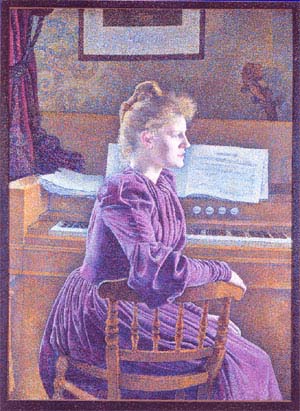
Maria Sèthe at the Harmonium
Théo Van Rysselberghe, 1891
Royal Museum of Fine Arts, Antwerpen
|
 Neo-Impressionism, imprisonment or liberation ?
Neo-Impressionism, imprisonment or liberation ?
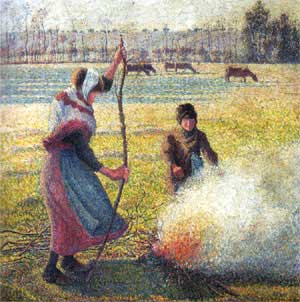 Young Peasant Lighting a
Fire,
Young Peasant Lighting a
Fire,
Hoarfrost
Camille Pissarro, 1887-89
Orsay Museum, Paris
|
|
|
From the beginning Camille Pissarro
was seduced by Seurat's Divisionism, and from 1886 to
1891 painted in a pointillist manner, although preferring small strokes
to dots, before he finally went back to a more Impressionist technique,
as he felt he was imprisoned in a too impersonal painting.
He later wrote in 1896 concerning the systematic
division of color : "I find it impossible to follow my sensations,
to give life and movement... Very likely I was not made for this art
which gives me the feeling of death levelling". Nevertheless,
Pissarro's technique will keep from this pointillist period a trend for
small color strokes.
Van Gogh, as he arrived in Paris
in 1886, also took a great interest in Seurat's theories and painted
several works in a pointillist manner.
|
|
Until his death in 1891, Seurat will apply in his large
major paintings an always more rigorous and austere divisionist
technique. The post-Seurat Neo-Impressionism was to free itself from
this strict pointillist technique in which Pissarro felt imprisoned,
especially through Paul Signac's work evolution.
 A new Neo-Impressionism
with SIGNAC
A new Neo-Impressionism
with SIGNAC
From 1892 on, Signac, a sailing lover, regularly
sejourns in Saint-Tropez. His style becomes more
intuitive and his color touches larger, his
palette more luxuriant.
"Compared with Signac's luminous and light
paintings, Seurat's paintings seem grey and immobile",
contemporary art critics Julius Meier-Graefe writes to describe the
chromatic intensity of Signac's paintings.
Thus Signac gives birth to a second
Neo-impressionism.
| |
From 1895 on, Signac "illuminates" Neo-Impressionism through
works as "La bouée rouge" (The red buoy) -1895, "Saint-Tropez,
l'orage" (saint-Tropez, the storm) - 1895, "Voiles et pins"
(Sails and pines) - 1896.
It is this new liberated Neo-Impressionism, its brilliant and
luminous colors, which will later influence the Fauve painters
and the Expressionists, whereas that of Seurat,
more rational, will attract attention of Cubist painters due
to its "scientific clarity of conception".
Unlike Impressionist painters, Seurat and Signac, wishing to
give a scientific and meaningful basis to their painting, will write
treatises which will have much influence over the young
painters who were to do the art of the XXth century ("From
Eugène Delacroix to Neo-Impressionism" - Paul Signac, 1898).
|
|
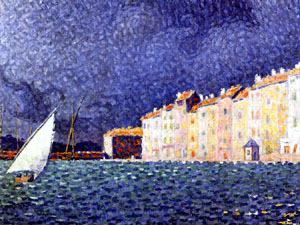 Saint-Tropez, the Storm
Saint-Tropez, the Storm
Paul Signac, 1895
Musée de l'Annonciade, St-Tropez |
 Neo-Impressionism, also
source of abstraction
Neo-Impressionism, also
source of abstraction
Neo-Impressionism, as a movement, will have only been a
transitional period in painting history, but its influence
appears essential to the evolution of XXth century
painting.
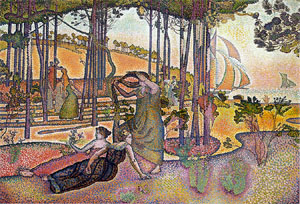 Evening Breeze
Evening Breeze
Henri Edmond CROSS, 1893-94
Orsay Museum, Paris |
|
|
Only very few artists, such as Signac or Cross,
will remain faithful to Neo-Impressionism, whereas for many others,
e.g. Matisse, Derain, Braque, it will only be a step
towards something new.
|
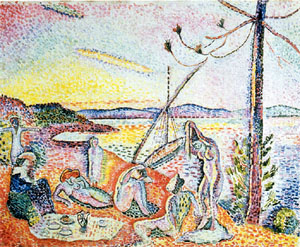 Luxury, Calm and Happiness
Luxury, Calm and Happiness
Henri Matisse, 1904-05
Orsay Museum, Paris |
|
|
This is the case when Henri Matisse,
after he had met with Signac at Saint-Tropez and Cross
at the Lavandou, paints "Luxe, calme et volupté" ("Luxury, Calm
and Happiness") - 1905, a work in which their influence appears
clarly, in the composition as well as in the use of a divisionist
technique .
It is then the beginning of Fauvism,
the monotonous and regular division of color touches of
Pointillism will extend to many other different forms, and colors will
soon take precedence over representation concern.
Modern art in the XXth century will emphasize non-realistic
stylisation in painting, to which Neo-Impressionism had opened the way.
|
 Neo-Impressionism, a
source of original works
Neo-Impressionism, a
source of original works
| |
Despite this aspect of Neo-Impressionism as an essential
contribution to art history, there remain, besides Seurat and Signac,
many beautiful works of little known painters.
One can measure the originality and the diversity
of these Neo-Impressionist artists, who transformed a difficult
technique into art : Dubois-Pillet, Angrand, Cross, Luce, Van
Risselberghe, Finch, Lemmen, Toorop...
|
|
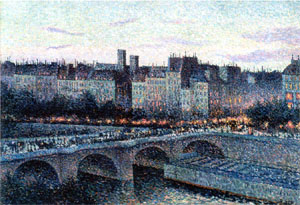 Quai de l'Ecole
Quai de l'Ecole
Maximilien Luce, 1889
Private Collection |


![]() Georges SEURAT (1859-1891), founder of
Divisionism
Georges SEURAT (1859-1891), founder of
Divisionism![]() 1886, the beginnings of
post-Impressionism : Symbolism and Neo-impressionism currents
1886, the beginnings of
post-Impressionism : Symbolism and Neo-impressionism currents







